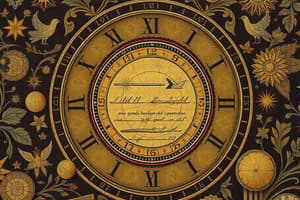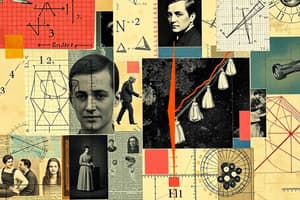Podcast
Questions and Answers
Which of the following is NOT a fundamental concept in graph theory?
Which of the following is NOT a fundamental concept in graph theory?
- Derivatives (correct)
- Edges
- Vertices
- Cycles
In the context of statistics, which measure of variability indicates how spread out data points are from the mean?
In the context of statistics, which measure of variability indicates how spread out data points are from the mean?
- Range
- Mode
- Median
- Standard Deviation (correct)
Which mathematical concept allows us to determine the rate of change of a function at a specific point?
Which mathematical concept allows us to determine the rate of change of a function at a specific point?
- Integrals
- Derivatives (correct)
- Matrices
- Limits
Which of the following is NOT a common application of mathematics in the field of finance?
Which of the following is NOT a common application of mathematics in the field of finance?
In the context of probability, what is the normal distribution often used to model?
In the context of probability, what is the normal distribution often used to model?
Which of the following is NOT a fundamental property of arithmetic? (Select all that apply)
Which of the following is NOT a fundamental property of arithmetic? (Select all that apply)
What type of function is represented by the equation $y = 3x^2 - 2x + 1$?
What type of function is represented by the equation $y = 3x^2 - 2x + 1$?
In Euclidean geometry, which of the following figures is NOT considered a quadrilateral?
In Euclidean geometry, which of the following figures is NOT considered a quadrilateral?
Which of the following concepts is NOT a core principle of calculus?
Which of the following concepts is NOT a core principle of calculus?
Which of the following mathematical structures IS NOT considered a fundamental abstract structure used in advanced mathematics?
Which of the following mathematical structures IS NOT considered a fundamental abstract structure used in advanced mathematics?
Which of the following best describes the role of mathematical proofs in mathematics?
Which of the following best describes the role of mathematical proofs in mathematics?
Which of the following is NOT a branch of mathematics mentioned in the provided content?
Which of the following is NOT a branch of mathematics mentioned in the provided content?
Which of the following statements best describes the relationship between arithmetic and algebra?
Which of the following statements best describes the relationship between arithmetic and algebra?
Flashcards
Permutations
Permutations
Different arrangements of a set of objects where order matters.
Probability Distribution
Probability Distribution
A function that describes the likelihood of all possible outcomes in a random event.
Mean (Average)
Mean (Average)
A measure of central tendency calculated by dividing the sum of values by their quantity.
Mathematics
Mathematics
Signup and view all the flashcards
Arithmetic
Arithmetic
Signup and view all the flashcards
Commutative Property
Commutative Property
Signup and view all the flashcards
Algebra
Algebra
Signup and view all the flashcards
Geometry
Geometry
Signup and view all the flashcards
Calculus
Calculus
Signup and view all the flashcards
Differential Calculus
Differential Calculus
Signup and view all the flashcards
Discrete Mathematics
Discrete Mathematics
Signup and view all the flashcards
Study Notes
Fundamental Concepts
- Mathematics is a systematic study of quantity, structure, space, and change.
- It encompasses various branches, including arithmetic, algebra, geometry, calculus, and more.
- Abstract mathematical structures like groups, rings, and fields are essential in advanced mathematics.
- Mathematical reasoning relies on logic and deductive argumentation.
- Mathematical proofs are crucial for establishing the validity of theorems and concepts.
Arithmetic
- Arithmetic deals with basic operations on numbers: addition, subtraction, multiplication, and division.
- Fundamental properties of arithmetic include the commutative, associative, and distributive properties.
- Number systems, including natural numbers, integers, rational numbers, irrational numbers, and real numbers, are essential.
- Understanding place value is crucial for performing arithmetic operations.
Algebra
- Algebra utilizes symbols to represent unknown quantities.
- It involves solving equations and inequalities.
- Linear equations and systems of linear equations are important topics.
- Quadratic equations and higher-order polynomial equations represent relationships and problems solvable using algebraic techniques.
- Functions, including linear, quadratic, and polynomial functions are pivotal in modeling relationships between variables.
- Factoring algebraic expressions helps to solve equations and simplify expressions.
Geometry
- Geometry studies shapes, sizes, and positions of figures in space.
- Euclidean geometry focuses on plane and solid figures in a 2D and 3D space.
- Geometric figures include lines, angles, triangles, quadrilaterals, circles, and three-dimensional shapes like cubes, spheres, and cones.
- Geometric transformations, including translations, rotations, and reflections, are crucial in understanding shapes.
- Concepts like area, perimeter, volume, and surface area are integral components of geometry.
Calculus
- Calculus involves the study of continuous change and motion.
- Differential calculus focuses on rates of change and slopes of curves.
- Derivatives and integrals are fundamental concepts in differential and integral calculus.
- Applications of calculus include optimization problems, determining areas and volumes, and modeling physical phenomena.
- Techniques like integration by parts and substitution are used.
Discrete Mathematics
- Discrete mathematics deals with distinct, countable objects.
- Topics include logic, sets, relations, and functions.
- Counting principles, like permutations and combinations, are central.
- Graph theory, investigating the relationships between objects, is a major area of study.
Statistics and Probability
- Statistics deals with collecting, analyzing, interpreting, and presenting data.
- Probability studies the likelihood of events occurring.
- Basic statistical concepts include measures of central tendency (mean, median, mode) and measures of variability (range, standard deviation).
- Probability distributions, such as the normal distribution, are used to model random phenomena.
Important Mathematical Concepts
- Sets: Collections of objects.
- Functions: Relationships between input and output values.
- Limits: Understanding behavior of functions at specific points.
- Continuity: Functions that don't have breaks.
- Derivatives: Rates of change, slopes of curves.
- Integrals: Finding areas under curves.
- Vectors: Quantities with magnitude and direction.
- Matrices: Arrays of numbers used in linear algebra.
- Complex numbers: Numbers containing a real and an imaginary part.
- Proof techniques: Proving mathematical statements.
Applications of Mathematics
- Science (Physics, chemistry, biology): Mathematical models explain phenomena.
- Engineering: Designing structures and systems.
- Computer Science: Algorithms and data structures.
- Finance: Modeling investment strategies and risk.
- Economics: Predicting markets and understanding consumer behavior.
Studying That Suits You
Use AI to generate personalized quizzes and flashcards to suit your learning preferences.




